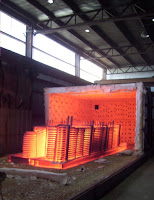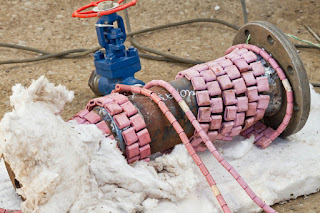https://hotfoilehs.com
609-588-0900
A blog that provides educational information on electric heating systems used on hoppers, chutes, tanks and vessels; electric heating systems used for pre and post weld heat treating; heat treating power consoles; custom heat treating furnaces; and single & multi-operator welders. For more information, visit HotfoilEHS.com
Heat treatment in any large-scale welding process (such as pipeline welding, shipbuilding, boiler manufacturing) is critical to a weld's efficiency and, therefore, essential in a structure's performance, and therefore its importance can never be overlooked.
An examination of industrial code or a consultation with a welding specialist is imperative if in doubt. A review of the welding code is the first determinant of whether preheating is required. The welding code carefully defines the minimum preheat, the temperature, the soak time, and the welding method. Many requirements, all obtained from years of rigorously checked data, are recognized by welding codes. This data is well supported by several sources, including metallurgical research, chemical material properties, and radiographic analysis.
Welding heat treatment in its simplest form is the process of heating the base metal (parts to being welded) before welding to the desired temperature and then allowing it to cool at a given rate under regulated conditions. The exact temperature the component needs to achieve (before welding) is called the "preheat temperature."
There are several main reasons why preheating before welding is necessary. A preheated part cools more slowly, which slows down the welded part's overall cooling rate. This slow cooling strengthens the metallurgy (crystalline structure), which makes it less susceptible to cracking. Hydrogen that could be present immediately after a weld is therefore released more effectively, reducing cracking risk. Preheating at the weld joint and surrounding metal often mitigates stress from the shrinkage. It is preheating that decreases the risk of fractures due to brittleness during processing.
Electric preheaters for welding, known as "ceramic mat heaters," are durable and versatile heating components built to fit evenly around the weld and surrounding area. Ceramic mat heaters are temperature controlled by a power console that uses thermocouples and electronic controllers to regulate the preheat temperature profile, track it, and record the temperature data.
Another less favored method for heating the target piece is with a torch or open flame, but this method has apparent safety issues and controllability problems. Also used are heat treat furnaces, but these usually involve off-site transport of the target item.
For safety, portability, and controllability, induction heaters give an appealing alternative. Induction heating is endorsed because, instead of open flames or external electrical components, it uses molecular excitation as its source of heat. Induction heating operates very rapidly, and there are far fewer worries about component contamination since there is no interaction with the target item. When very high temperatures and uniform control is required, many industrial processes use induction heating.
It is critically important to review and discuss your heat treating requirements with an expert before welding. Don't risk safety or waste time and money by "winging it" when it comes to heat treatment.
Hotfoil-EHS
609-588-0900
www.hotfoilehs.com
 |
| Indirect resistance heating example: Weld preheat ceramic mat heater. |
 |
| Indirect resistance heating example: Clamp-on pre-weld electric heater. |
 |
| Indirect resistance heating example: Electric hopper heaters. |
 |
| Heat treatment furnace. |
 |
| PWHT with resistance heaters |
 |
| Welding between insulated heating areas Heating done by ceramic heaters (pink). |
 |
| Ceramic heaters on spool piece. |
 |
| Welding pre-heat is critical to the quality of the weld and and the integrity of the structure. |
 |
| Welding a large pipe with localized heating using ceramic mat heaters. |
 |
| Preparing the pipe for the weld and allowing the heaters to raise the temperature of the pipe. |
 |
| Wrapping ceramic mat heaters around spool piece. |
 |
| Close-up of ceramic mat heaters around spool piece. |
 |
| Weather-proof, Stainless Steel Power Console |
 |
| Power console and custom cable sets |
 |
| Custom painted power console |
 |
| Ceramic mat heaters |
 |
| Ceramic mat heater for pre and post weld heat treatment. |